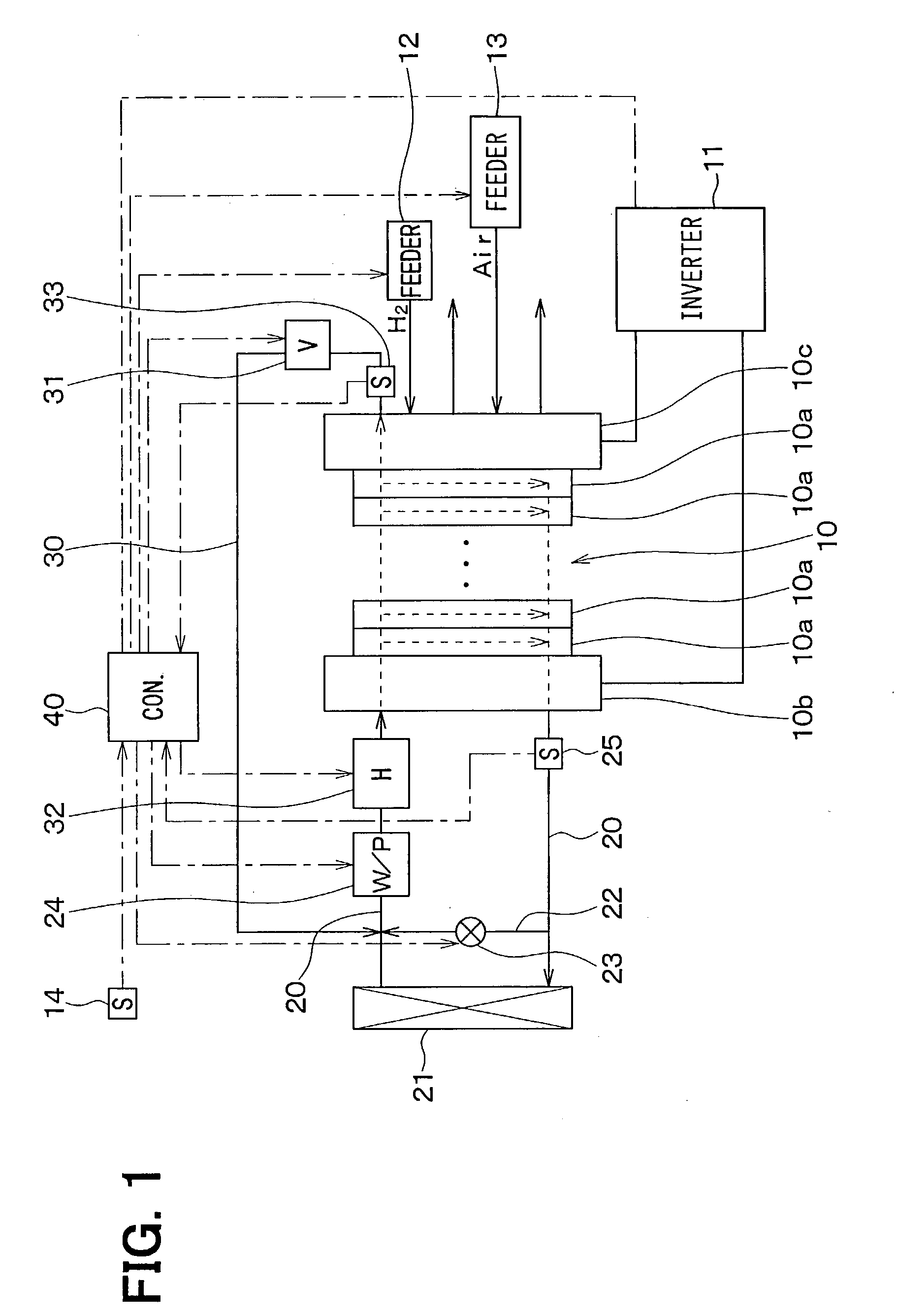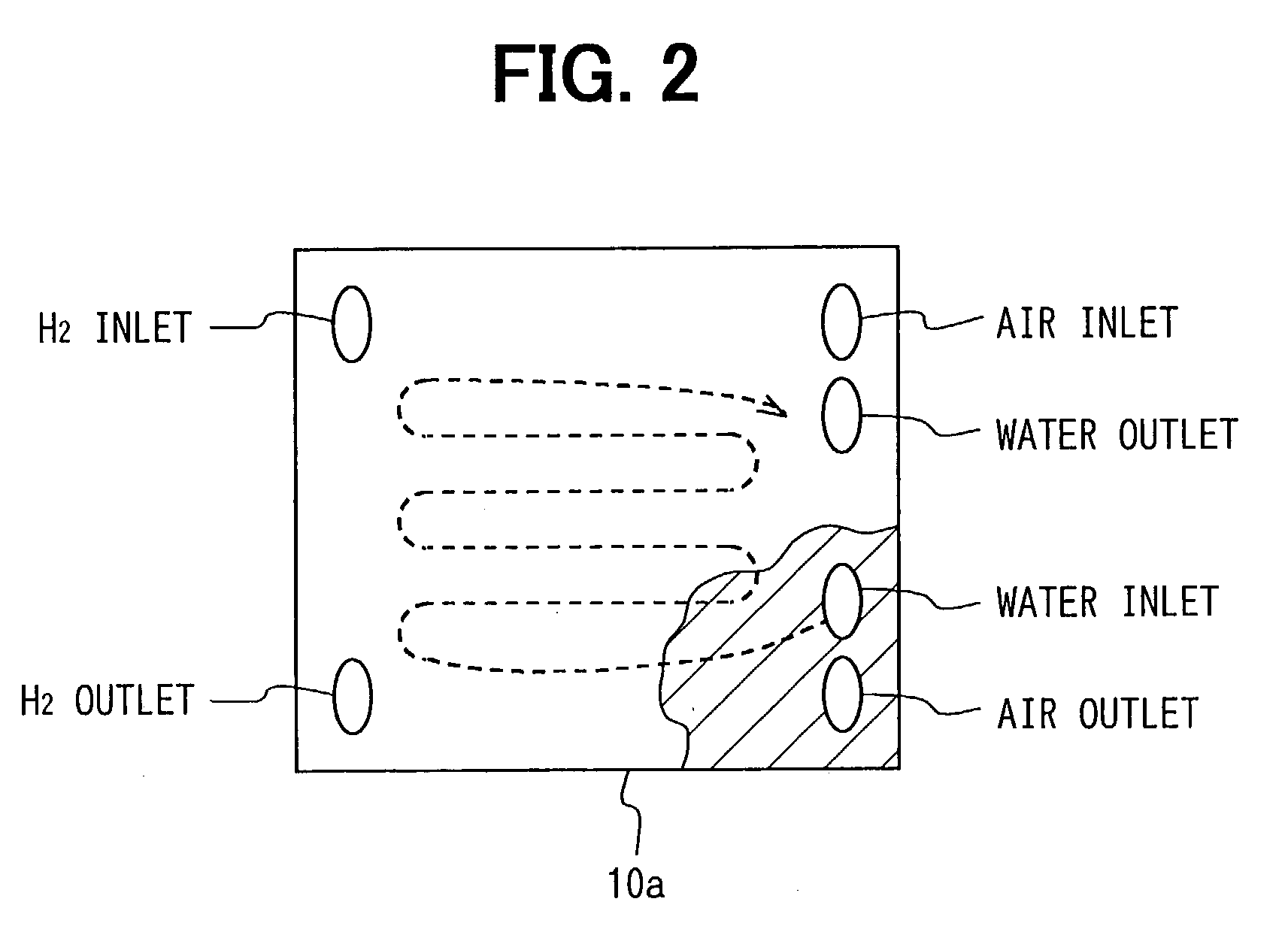Fuel cell system
- Summary
- Abstract
- Description
- Claims
- Application Information
AI Technical Summary
Benefits of technology
Problems solved by technology
Method used
Image
Examples
seventh embodiment
[0131] (Seventh Embodiment)
[0132] In a fuel cell system of the seventh embodiment, a heating device using electric power generated by the fuel cell 10 is added to the fuel cell system described in the above sixth embodiment. In the seventh embodiment, the same portions as the sixth embodiment are indicated by the same reference numerals, and description thereof is omitted.
[0133] FIG. 12 shows an entire structure of the fuel cell system of the seventh embodiment. As shown in FIG. 12, an electric heater 39 is provided in the heating path 26. The electric heater 39 heats cooling water flowing in the heating path 26 using electric power supplied from the fuel cell 10.
[0134] Electric power generated by the fuel cell 10 is consumed as motive power of a main motor for running a vehicle, as motive power of peripheral accessories for charging a secondary cell and the like through the inverter 11. However, a vehicle is generally stopped during the warm-up operation of the fuel cell 10, and ch...
eighth embodiment
[0136] (Eighth Embodiment)
[0137] In a fuel cell system of the eighth embodiment, as shown in FIG. 14, the first temperature sensor 33 is eliminated from the fuel cell system described in the above seventh embodiment. In the eighth embodiment, the same portions as the seventh embodiment are indicated by the same reference numerals, and description thereof is omitted.
[0138] As shown in FIG. 14, the first temperature sensor 33, provided in the bypath path 30 around the water outlet of the fuel cell 10 in FIG. 12, is eliminated. Further, the second temperature sensor 25, provided in the thermal medium circulation path 20 around the water outlet of the fuel cell 10 in FIG. 12, is provided in the thermal medium circulation path 20 at a downstream side of a connection point between the thermal medium circulation path 20 and the bypass path 30.
[0139] According to the eighth embodiment, when a part of the fuel cell 10 is collectively heated by circulating cooling water only in the bypass pat...
ninth embodiment
[0141] (Ninth Embodiment)
[0142] In the ninth embodiment, an arrangement position of the heater 32 is different from that in the above-described sixth embodiment. In the ninth embodiment, the same portions as the sixth embodiment are indicated by the same reference numerals, and detail description thereof is omitted.
[0143] As shown in FIG. 16, in the ninth embodiment, the bypass path 30 is connected to the thermal medium circulation path 20 at a position downstream from the water pump 24 and upstream from the fuel cell 10. The heater 32 is provided in the bypass path 30 at a downstream side of the bypass water pump 38. In this construction, when a part of the fuel cell 10 is collectively heated, cooling water is circulated into the bypass water pump 38, the heater 32 and the part of the fuel cell 10, in this order. Further, the radiator bypass path 22 through which cooling water bypasses the radiator 21, and the temperature control valve 23 for adjusting the amount of cooling water f...
PUM
| Property | Measurement | Unit |
|---|---|---|
| temperature | aaaaa | aaaaa |
| temperature | aaaaa | aaaaa |
| temperature | aaaaa | aaaaa |
Abstract
Description
Claims
Application Information
 Login to View More
Login to View More - R&D
- Intellectual Property
- Life Sciences
- Materials
- Tech Scout
- Unparalleled Data Quality
- Higher Quality Content
- 60% Fewer Hallucinations
Browse by: Latest US Patents, China's latest patents, Technical Efficacy Thesaurus, Application Domain, Technology Topic, Popular Technical Reports.
© 2025 PatSnap. All rights reserved.Legal|Privacy policy|Modern Slavery Act Transparency Statement|Sitemap|About US| Contact US: help@patsnap.com



